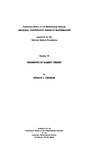It is no exaggeration to say that within the past several years there has been a veritable explosion of activity in the general field of combinatorics. Within this domain, one particular subject has enjoyed even more remarkable growth. This subject is Ramsey theory, the topic of these lecture notes. The notes are based rather closely on lectures given at a Regional Conference at St. Olaf College in June, 1979. It was the purpose of the lectures to develop the background necessary for an understanding of these recent developments in Ramsey theory. In keeping with the style of the lectures, the notes are informal. However, complete proofs are given for most of the basic results presented. In addition, many useful results may be found in the exercises and problems.
Loosely speaking, Ramsey theory is that branch of combinatorics which deals with structure which is preserved under partitions. Typically one looks at the following kind of question: If a particular structure (e.g., algebraic, combinatorial or geometric) is arbitrarily partitioned into finitely many classes, what kinds of substructures must always remain intact in at least one of the classes?
During the past few years, a number of spectacular advances have been made in the field of Ramsey theory. These include, for example, the work of Szemer?di and Furstenberg settling the venerable conjecture of Erd?s and Tur?n (that a set of integers with no k-term arithmetic progression must have density zero), the Nesetril-R?dl theorems on induced Ramsey properties, the results of Paris and Harrington on "large" Ramsey numbers and undecidability in first-order Peano arithmetic, Deuber's solution to the old partition regularity conjecture of Rado, Hindman's surprising generalization of Schur's theorem, and the resolution of Rota's conjecture on Ramsey's theorem for vector spaces by Graham, Leeb and Rothschild. It has also become apparent that the ideas and techniques of Ramsey theory span a rather broad range of mathematical areas, interacting in essential ways with parts of set theory, graph theory, combinatorial number theory, probability theory, analysis and even theoretical computer science.
It is the purpose of these lecture notes to lay the foundation on which much of this recent work is based. Most of what is covered here is treated in considerably more detail in the recent monograph Ramsey theory by Graham, Rothschild and Spencer.
Relatively little specialized mathematical background is required for this book. It should be accessible to upper division students.
(Published with support from the National Science Foundation)
 |
|
О проекте
|
|
О проекте


